



Pitch is an attractive raw material for carbon fiber precursors due to its low cost stemming from its availability as a residue of coking and petroleum processes. Ford Motor Company reported a carbon fiber target price of $11.0/kg by using a fast cycle-time manufacturing method with carbon fiber in an inexpensive format, allowing for an average retail price of gasoline of $3.58/gallon. They also recommended the use of carbon fiber with strength of 1700 MPa, modulus of 170 GPa, and 1.5% elongation. This study introduced a ca. 5.5μm carbon fiber with 2000 MPa tensile strength obtained from a precursor through simple distillation of petroleum residue. Petroleum pitch based carbon nanofibers prepared via electrospinning were characterized and potential applications were introduced on the basis of their large specific surface area and relatively high electrical conductivity.
Demand for various types of carbon fibers has recently increased owing to both their desirable mechanical properties and cost-effectiveness. The respective mechanical properties of commercial polyacrylonitrile (PAN)/mesophase pitch-based carbon fibers are 3.0-5.7 GPa/1.4-2.2 GPa tensile strength; 230-300 GPa/140-820 GPa tensile modulus; and 1.3%-1.9%/0.2%-1.1% elongation. PAN-based carbon fibers exhibit higher tensile strength and larger elongation, thereby lending greater flexibility, although their modulus is relatively lower when compared to that of mesophase pitch-based carbon fibers. The mechanical properties of commercial fibers exceed those of commonly used steel and aluminum. On the other hand, the mechanical properties of pitch-based general-purpose carbon fibers exhibit a wide gap relative to those previously mentioned by 0.5-1.0 GPa tensile strength, 30-40 GPa modulus, and 1.4%-2.4% elongation. The requirements for carbon fiber products used in automotive applications are considerably lower than what is currently available, as shown in Table 1. For example, Jim deVries at Ford Motor Company [1] recommended the use of carbon fiber with a strength of 1700 MPa, modulus of 170 GPa, and 1.5% elongation.
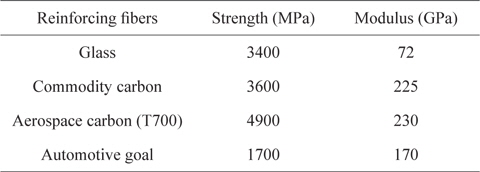
Properties of carbon fibers available for commercial use and requirements for automotive applications [1]
In this sense, there is a strong demand for carbon fibers that possess properties within the vacancies that are not covered by general-purpose pitch-based carbon fibers and high-performance carbon fibers, including those based on PAN and mesophase pitch. Such carbon fibers can be realized via design of the molecular structure of the precursor pitch from selected residues [2,3].
It has recently become necessary to reduce the weight of automobiles in order to allow the adoption of electrical vehicles. Carbon fiber composites are the best choice among existing materials, and the only hurdle for carbon fibers is their prohibitive cost for application to commercial automobiles. Accordingly, there is a strong demand in the automotive industry for carbon fibers with lower cost and moderate mechanical properties.
Pitch is an attractive raw material for use as a carbon fiber precursor due to its low cost stemming from its availability as a residue of coking and petroleum processes. PAN-based carbon fibers have a relatively high cost of US$20-30/kg, and mesophase pitch-based carbon fibers are even much more expensive, although their mechanical properties are excellent. The cost of carbon fibers must be competitive when compared to Al for body panels. Jim deVries at Ford Motor Company reported a carbon fiber target price of $11.0/kg obtainable by using a fast cycletime manufacturing method with carbon fiber in an inexpensive format [1-7], allowing for an average retail price of gasoline of $3.58/gallon over 72 months since 2003.
Also, carbon nanofibers (CNFs) have potential for use in various new applications such as electrodes, catalyst supports, adsorbents, composites, etc., due to their large surface area and relatively high electrical conductivity.
Pitches are residues from refining petroleum oils and coal, and are mixtures that consist of condensed aromatic molecules with a wide range of relative molecular weights. Pitch precursors (PPs) for carbon fibers are synthesized by condensation of the residues from coking or petroleum processes. The condensation methods generally used are air blowing for dehydration condensation [3,7,8], supercritical extraction [9-12], and halgenatation/ dehydohalgenation [13-17], and these processes are followed by distillation and thermal treatment. The average molecular structures of the precursors are sensitively dependent on the source of the raw material and on the condensation methods used. The characteristics of the carbonized fibers are also very sensitively dependent on the precursor material and on the processing conditions, such as the stabilization and carbonization.
The composition of petroleum pitches varies to a significant degree depending on the feed stock used for the production and processes that are applied. The common feature of a petroleumbased pitch is 10%-20% lower aromaticity than that of coal tar pitch. Accordingly, petroleum-based pitches contain a higher portion of alkyl substituted and partially hydrogenated polycyclic aromatic hydrocarbons. The molecular weight distribution of the petroleum-sourced pitch is broader, and the average molecular weights are higher when compared to that of coal tarbased pitch [18-22].
Three kinds of pitches are discussed with respect to their properties, and respective applications on the basis of these properties are sought. The precursor pitches used are prepared via thermal treatment (Anshan East Asia Carbon Fiber Co., China, AN-PP); from petroleum-based PPs prepared through condensation of pyrolyzed fuel oil (PFO) with Cl2 (Hanwha Chemical Co., Korea, Cl-PP) [16,17]; and from bromination of 2-methylnaphalene followed by dehydrobromination/polymerization and extraction in n-hexane to eliminate light components (Br-mNP) [23]. The properties of the pitches are summarized in Table 2.
[Table 2.] Comparison of pitches prepared via various methods
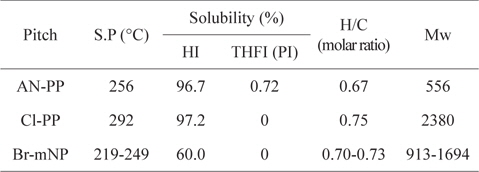
Comparison of pitches prepared via various methods
The data show that the solubilities of Cl-PP and Br-mNP are much higher than that of AN-PP. Accordingly, higher solubility enables measurement of relatively higher molecular weight, and a higher H/C value of a chemically synthesized pitch represents more aliphatic groups than that of AN-PP. The solid 13C and 1H nuclear magnetic resonance (NMR) spectra of AN-PP and Cl-PP show broad peaks at 0-50 ppm and 100-150 ppm, but there is a more intensive peak for Cl-PP at 0-50 ppm of 13C and at 1-3 ppm of 1H NMR [24] (Figs. 1 and 2).
The spectra indicate that the chemically synthesized Cl-PP and Br-mNP pitches contain more abundant aliphatic groups with more hydrogen when compared to that of AN-PP. The 13C data of Br-mNP presented a newly formed C4 that increased with an increasing degree of 2-methylnaphthalene polymerization in the as-prepared pitches [23,24]. The flexible methylene crosslinkage between the naphthalene units contributes to the solubility and linearity of the molecule to be formed as a flexible fiber precursor. The average molecular structures of the three pitches proposed are shown in Fig. 3
The solution properties were investigated for the same concentration and temperature levels [24]. The electrical conductivity and viscosity of Cl-PP were 0.15 μS/cm and 739 cP, respectively, while those for AN-PP were 0.35 μS/cm and 629 cP. A higher viscosity and lower electrical conductivity was observed for Cl-PP than for AN-PP. The respective behaviors of Cl-PP are expected from a molecular structure with a lower aromatic component but higher molecular weight, and vice-versa. The lower electrical conductivity of Cl-PP would be beneficial for higher charge density on the jet surface and higher viscosity rusting for better spinnabilty in electrospinning. The PPs can be electrospun into fibers of 2-5 μm in diameter from Cl-PP and 1-2 μm from Br-mNP [23,25].
Kim
Hanwha Co. produced precursor pitches of various softening points at a pilot scale via condensation of PFO through chlorination/ dehydrochlorination (HPCP-67). The properties of the precursor pitch and of the fibers carbonized at 1000℃ are summarized in Tables 3 and 4, respectively.
[Table 3.] Select properties of precursor pitch of HPCP-67

Select properties of precursor pitch of HPCP-67
[Table 4.] The characteristics of carbonized fibers from HPCP-67 at 1000℃

The characteristics of carbonized fibers from HPCP-67 at 1000℃
Kim
3. Pitch Based CNFs from Electrospinning
Carbon nanomaterials, such as graphene and carbon nanotubes, present excellent performance on the basis of their specific gravimetric density. There are hurdles to increase the specific volumetric density for electrode applications, however, in order to approach high volumetric energy density. Nano-sized carbon fibers from electrospinning are one of the promising technologies that can meet these demands [35,36].
The strengths of electrospinning are that it can achieve the following:
● Large specific surface area for super capacitor applications, catalyst support● Large aspect ratio as a self-standing material, and low volume fraction for electron conduction● Easy fiber formation process for blended multi-function materials; pore size control can be achieved with the help of additives● Feasible mass production without catalysts for low-cost production as electrode materials● Tunable volumetric density via alignments of individual fibers [35,36].
The electrospinning of the pitch is dependent on the viscosity and on the stretchability that results from the molecular structure, tunable via a synthetic method, of the raw materials. Cl-PP-based carbon fibers from electrospinning showed much higher electrical conductivity (50 S/cm) and higher specific surface area (2054 m2/g) with wider pore diameter (25 Å) than those from polymer-based electrospun CNFs (Figs. 5a and b) [37,38].
Park
The PAN-pitch-solvent ternary phase diagram is presented in Fig. 7a [45-49]. Phase A indicates a homogeneous solution, phase B indicates a biphasic solution, and phase C indicates a mixture of a solid solute and a solvent. The shaded region in phase B denotes high spinnability, which is suitable for the formation of homogeneous nano-fibers. The ternary phase diagrams show that the phase B is wider that for PAN/Cl-PP, representing wider spinnable compositions from a higher solubility of the Cl-PP than the AN-PP.
The spinnability of pitch electrospinning could be obtained by blending a polymer of excellent spinnability such as PAN [50]. PAN/Cl-PP and PAN/AN-PP blend solutions were prepared to improve the poor spinnability of the pitch due to the low molecular weight and/or low solubility. Kim

Electrical conductivities of the single carbon nanofibers of various pitch concentrations measured by current-voltage profile in a range of -1.0 to 1.0 V.
Using a PAN/pitch blend solution of 7/3, a bendable web (Fig. 8b) with an average diameter of 150 nm without any beads was produced (Fig. 8c). Noticeably, the transmission electron microscopy image (Fig. 8d) shows that an individual CNF exhibits two-phase separation. Since there are substantial differences in the basic features of the two constituent polymers in the solution, the pitch with lower molecular weight was preferentially located in the shell [45,50]. Energy-dispersive X-ray spectroscopy observation of the two phases revealed the presence of nitrogen and oxygen in the core and only carbon in the skin of the air-stabilized fibers (Fig. 8e). The absence of nitrogen and oxygen atoms in the shell is attributed to the nature of the pitch and the dehydration reaction of the diffused and adsorbed oxygen atoms. Two phases and well-developed crystalline layers were observed in the skin of the fiber, as shown in Fig. 8f.
When the Cl-PP concentration in THF decreased at a fixed PAN concentration, smaller pore sizes were more predominantly developed, providing a higher Brunauer-Emmett-Teller (BET) surface area (Figs. 9a and b). The pore size distributions of PAN/Cl-PPderived CNFs, from density functional theory (DFT) calculations, exhibited tunable pore size distributions from 0.6 nm to 1.4 nm resulting from the variation of the pitch concentration. A scanning tunneling microscopy (STM) analysis provided more information on the domain size and micro-structure of the domains of the CNFs. As the pitch concentration increased, the shape of the surface changed from a small particle-like flat morphology to plate-like and to a large particle-like morphology. The domain size of the CNFs derived from PAN/pitch increased with an increase in pitch concentration (Figs. 10a-d). Naturally, the larger domain size resulted in larger pores with smaller specific surface areas. The domain structures observed by STM were consistent with the BET surface areas and pore size distributions.
The tunable pore size was examined to elucidate the effect of the pore size on the capacitance of a supercapacitor electrode. The electrochemical properties of the PAN/pitch-derived CNF webs were studied via CV in a 6 M KOH aqueous electrolyte solution.
According to the Ragone plot (Fig. 11), both the fibrous morphology and the optimized pore sizes allowed the PAN/pitchderived CNF electrode to achieve both a high energy density (ca. 15.0 Wh kg-1) and a high power density (ca. 100 kW kg-1) simultaneously. The Ragone plot also shows a higher power density can be obtained without significant degradation of the energy density.
Precursor pitches can be synthesized from residual oil or from pure chemicals through thermal treatment or chemical reactions. The thermal treatment introduces radicals that form larger molecules and larger aromatic components in the molecule. On the other hand, condensation reactions through halogenation/dehydrohalogenation occur with hydrogen of the alkyl groups, allowing alkyl groups in the precursor molecules. Accordingly, the pitches are relatively more soluble and the molecular structure is rather linear, showing enhanced spinnability. The molecular structure could be controlled by optimization of the reaction rate resulting from the reaction temperature or the reactivity of halogens such as Cl2 and Br2. Br-EB and Th-EB exhibit a Bingham behavior, suggesting that Br-EB and Th-EB have a molten state similar to that of mesophase pitches. Such molecular structures of the precursors showed specific rheological properties that present behaviors with mesogen in the molecule from the condensed precursor of the bromination/dehydrobromination residue of naphtha cracking. The carbonized fibers from the precursor resulted in a higher tensile strength than that achieved through thermal treatment. The results suggest there is potential to enhance the mechanical properties by adjusting the molecular structure of the precursor. The elctrospun carbonized fibers introduce new possibilities for applications that exploit a high specific surface area with a fine-sized diameter and shallow pores on the surface. A narrower pore size distribution and larger specific surface area could be obtained from Cl-PP than from ANPP at the same activation conditions. There is also potential to use Cl-PP-based carbon fibers for electrodes in supercapacitors, gas storage, and catalyst support.
![Properties of carbon fibers available for commercial use and requirements for automotive applications [1]](http://oak.go.kr/repository/journal/13513/HGTSB6_2014_v15n3_162_t001.jpg)




![The η' curves of Br-EB and Th-ED showing the effects of temperature [26].](http://oak.go.kr/repository/journal/13513/HGTSB6_2014_v15n3_162_f004.jpg)


![Characteristics of electospun carbon nanofibers [37,38]. PAN: polyacrylonitrile, PI: polyimide, PBI: polybenzimidazole.](http://oak.go.kr/repository/journal/13513/HGTSB6_2014_v15n3_162_f005.jpg)
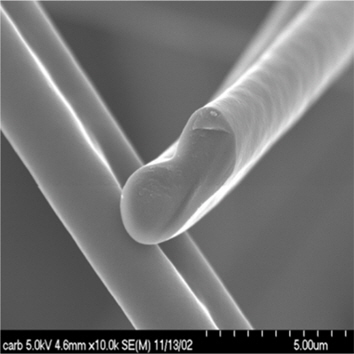
![Ternary phase diagram of polyacrylonitrile (PAN)/pitch/solvent; PAN in dimethylformamide and pitch in tetrahydrofuran solvent. Phase A, homogeneous solution; Phase B, biphasic solution; Phase C, mixture of solid solute and solvent; shadow region in phase B; spinnable composition [45]. PP: pitch precursor.](http://oak.go.kr/repository/journal/13513/HGTSB6_2014_v15n3_162_f007.jpg)

![Morphological structure of carbonized fibers from electrospinning of polyacrylonitrile/Cl-PP blends. (a) Photograph showing a bendable carbon nanofibers (CNFs). (b) Scanning electron microscopy image of CNFs. (c and d) Transmission electron microscopy (TEM) images of CNFs. (e) Energy-dispersive X-ray spectroscopy spectroscopy of air-stabilized nanofibers. (f ) TEM of CNFs thermally treated up to 2800℃ in argon [45]. PP: pitch precursor.](http://oak.go.kr/repository/journal/13513/HGTSB6_2014_v15n3_162_f008.jpg)
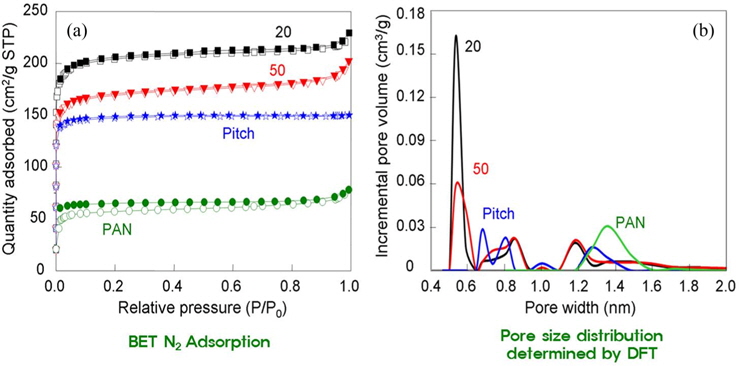
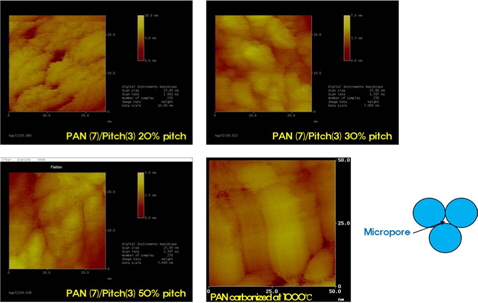
![Ragone plots (note that the PC value indicates the pitch concentration in tetrahydrofuran) [45]. PAN: polyacrylonitrile.](http://oak.go.kr/repository/journal/13513/HGTSB6_2014_v15n3_162_f011.jpg)